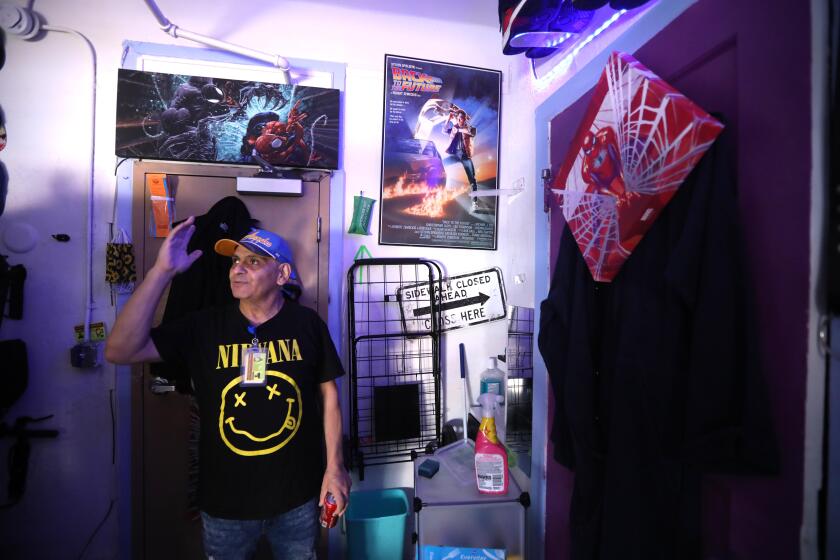Report Says 1 of 3 Finish Drug Rehab
Nearly two-thirds of California drug offenders who began rehabilitation programs between July 2001 and June 2002 did not finish them, according to UCLA researchers who evaluated a California law that sends defendants to treatment rather than prison.
Researchers said the report, which is being released today, was the first to show statewide results since Proposition 36 took effect three years ago. The results could be crucial as legislators consider whether to continue the annual $120 million for treatment programs, probation and other costs. The funding ends in 2006.
The law, which was passed by 61% of voters, represented a dramatic shift in how the courts deal with drug users. According to the 148-page report, which evaluated the program through June 30, 2003, the rates at which drug abusers completed programs were typical of drug users in other court-mandated programs.
“Considering the scale of it, what’s happened with Proposition 36 is about what you would have expected,” said Douglas Longshore, the lead researcher. “It is not an easy thing to stick with a program to the finish.”
More than half of those who entered treatment programs received at least 90 days of services, the study said.
Longshore said sticking with treatment for that long increases the chance that drug users will “turn a corner” toward completing rehabilitation.
Whites and Asians were more likely to complete the programs, or at least make it to the 90-day milestone, than African Americans and Latinos, the study concluded. Researchers attributed the racial gap to more African Americans and Latinos needing residential treatment but instead being placed in outpatient programs because of cost and availability.
Del Sayles-Owen, deputy director of the state Department of Alcohol and Drug Programs, said California has succeeded in diverting thousands of offenders into treatment, although many have never been to rehabilitation before and have been abusing drugs for many years.
“We’re off to a good start,” she said. “We are working with a lot of people who have a lot of barriers.”
Typical of the drug abusers who participate is Sonja Boyce, 27. She said it would be difficult to beat her two-year addiction to heroin. She was arrested for drug possession in August and begins rehabilitation next week.
But she fears that Proposition 36 is “a setup for failure” because participants can get caught using drugs three times before facing any consequences.
Boyce, who appeared in a downtown Los Angeles courtroom Wednesday, said she has used heroin once since her release from jail. “It’s hard every day,” she said. “The addiction is so insane. It’s all you think about.”
Offenders do not complete treatment for many reasons. Some encounter too many obstacles -- lack of jobs, transportation or housing, officials said.
Others are mentally ill or so seriously addicted that they need more intense help. Others are ambivalent about treatment and relapse, or are rearrested.
Some law enforcement officials and judges said offenders were getting too many chances before facing consequences. And they said those who keep using drugs commit crimes to support their addictions.
“I don’t think the law was a good idea,” said Ventura County Chief Deputy Dist. Atty. Mike Frawley. And the way it is being implemented creates a public safety problem, he said. “You’ve got known drug users out in the community continuing to use drugs ... and we don’t do anything about it.”
The criminal justice community may propose an amendment to the law that would allow for more sanctions, said Los Angeles County Superior Court Judge Ana Maria Luna. Though there have been some obstacles, Luna said that about 5,000 offenders -- many with a long history of drug abuse -- are receiving treatment in the county.
Statewide, 30,469 people entered treatment under Proposition 36 in the first year, with 10,481 completing treatment. In the second year, 35,947 started programs, but the number of graduates was unavailable.
Thousands of defendants who agreed to participate never started treatment, the study said.
A judge can give them a second chance to join a rehabilitation program, but can send them to prison after more failures.
Defendants who are not placed under Proposition 36 can be sent to county jails or state prison for drug-related convictions, depending on the charge.
Supporters say the UCLA report shows that the initiative is working -- for offenders and taxpayers.
Proposition 36 is saving state residents money by reducing the number of drug offenders in prison, which can cost about $30,000 each year per inmate, said Glenn Backes, director of the Drug Policy Alliance.
“It is a huge policy success and a huge success for families who do not have to see their loved ones out on the streets using drugs,” Backes said.
On Wednesday, Los Angeles County Superior Court Judge Mary Strobel presented Leopoldo Lopez, 45, with a graduation certificate and dismissed his drug conviction.
“You should feel very proud of yourself,” she told him. “You’ve done a lot of hard work.”
Lopez smiled and said through a Spanish interpreter, “So I don’t have to come back anymore?”
Strobel laughed and told him no, he was done.
More to Read
Sign up for Essential California
The most important California stories and recommendations in your inbox every morning.
You may occasionally receive promotional content from the Los Angeles Times.










